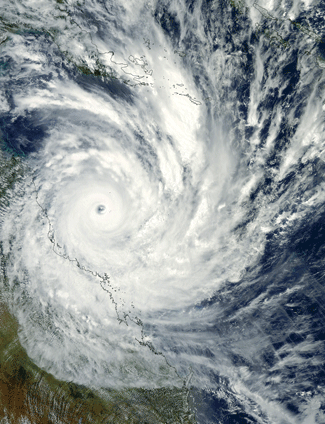
|
Published: 9 March 2011
Sunshine state tourism heeds weather warnings
Tropical Cyclone Yasi and the devastating floods in south-east Queensland came as a double blow to the state’s tourism industry this summer. But some tourist operators were better prepared than others, thanks to the foresight of Tourism Queensland – and a CSIRO information tool that enables operators to better manage business risks in the face of extreme climate events.

|
|
Yasi, a Category 5 cyclone, about to make landfall on 2 February. Credit: NASA
|
Tourism brings in $9.2 billion each year to Queensland, employing 122 000 people directly and 10 000 more indirectly. In 2010, the Australian tourism industry was already battling a downturn in global travel and a surging Australian dollar. Then, Oprah Winfrey touched down on Hamilton Island wearing an Akubra hat in perfect Whitsundays weather – a sunny 28 degrees and a blue sea. For Queensland tourism operators, 2011 was shaping up to be a good year.
But just over a month later, floods inundated the state’s south-east; soon after, cyclones Anthony and Yasi slammed into the north-east. The latter brought winds up to 285 km h-1 at Mission Beach, near where it made landfall. The storm surge destroyed roads and other structures hundreds of metres inland. Few of the state’s tourist operators could have predicted that Queensland would experience two of its worst natural catastrophes in living memory within a month of each other.
According to climate scientists, however, large intense cyclones and severe floods will become a fact of life in Australia as ocean warming amplifies the weather patterns associated with the La Niña and El Niño cycle. Although the recent events in Queensland have not been directly linked to climate change, they have certainly tested Australia’s readiness to deal with such impacts.
Through its ‘Weatherproof Your Business’ program, Tourism Queensland had the foresight some years ago to get its members looking at how events such as cyclones or flooding might affect tourism operations.
The program enables tourism operators to create crisis response plans for their business in preparation for emergencies. It also shows them how to plan for recovery by working with other local tourism businesses to overcome the devastation caused by extreme weather events.
‘It was the first time we had been able to engage with operators to look into the future,’ Ms Therese Phillips said to ECOS on the day Cyclone Yasi was due to make landfall in North Queensland. Ms Phillips is Tourism Queensland’s Industry Innovation Manager, responsible for helping to future-proof the industry.
‘It was such a lovely moment in the meetings when the light bulb went on with some of our members. Unfortunately for some, it will become a reality in Cairns tomorrow.’

|
|
Before the storm: Mission Beach with Dunk Island in the background; the eye of Cyclone Yasi passed over this area, damaging beaches and rainforest. Credit: Tourism Queensland
|
Through the ‘Weatherproof Your Business’ program, Cairns hotel owners were asked to think about how they would respond to the bigger storm surges that scientists are predicting for the future. The first thing they realised was that the hub of their operations – the reservations area – was located on the ground floor, and likely to be flooded.
Ms Phillips was able to extend the operators’ planning horizon even further, after she heard CSIRO scientist Dr Colette Thomas at a conference explaining what Queensland might look like under a possible future climate change scenario.
‘What she was saying and the way she presented it was what we had been looking for – we had been trying to educate our members about impacts of changing climate to get them to engage in forward-planning exercises,’ said Ms Phillips.
‘We want to take our members out of the here and now and get them thinking about the future. For example, there are predictions that in future they could be facing more intense cyclones than Yasi. How would they respond?’
In a series of meetings, Dr Thomas explained the science of climate change to tourist operators and sought their feedback on meaningful indicators relevant to their businesses.
‘To be prepared for events such as the January floods, it’s important that communities are aware of and understand Australia’s variable climate and its potential impacts,’ said Dr Thomas.
‘It’s also important that scientists learn from these impacts if they do occur. This requires integrating knowledge and experience gathered at the local level with information at higher levels.’
Dr Thomas and her CSIRO colleagues used this two-way knowledge exchange to develop a simple decision-making tool based on future climate scenarios developed by the CSIRO and the Bureau of Meteorology. The tool presents a series of storylines using relevant environmental indicators such as increased wind speed, air temperatures, and loss of animals and plants.
For example, one storyline projects a warmer and wetter climate for 2030, which could cause a 1–1.5°C increase over baseline temperature; flood impacts on airports, roads and rail; and increased mosquito and insect hazards.
‘Operators need to plan for a range of possible scenarios, and fully understand the climate change impacts on supply chains, business operations and customers,’ said Dr Thomas. ‘That’s why a risk management approach is recommended.’
The tool enables operators to look ahead as far as 2050, and includes a template for planning their own adaptation responses for their respective businesses.
As with the broader community, some operators in the industry do not accept the theory of climate change. ‘But,’ said Ms Phillips, ‘what we are saying is we don’t care if you believe in climate change: do you believe that the climate is becoming more extreme, more volatile?
‘The message is so important, because this industry relies on the natural environment, and is susceptible to impacts from weather and climate extremes. Therefore, if you take action now that can reduce your bills, you can stay in business.
‘Some reef cruise operators have slowed the journey from Cairns to Green Island so that it takes 20 min more, but uses one-third less fuel. They have concentrated on making the journey more enjoyable for tourists.
‘You don’t have to do something or build something; you just have to change what you’re doing. We want you to be in business in five years’ time, so think about what might happen in the future and plan for it.’
|
Scientists will discuss the latest findings in climate change science with leaders from government, community and industry at the next GREENHOUSE 2011 conference in Cairns, 4–8 April. |
This year’s event includes a ‘Communicating climate change’ stream that features a presentation – ‘Emotional responses to climate change: a missing link to behaviour?’ – by CSIRO’s Professor Iain Walker, Research Group Leader for the Social and Behavioural Sciences Group. Prof. Walker’s group applies social sciences to the challenge of understanding how people respond to natural resources issues such as water scarcity and climate change. |
Results from a recent nationwide survey of Australians by Prof. Walker’s group show that the dominant responses to the subject of climate change were largely either fear or irritation. Most people accept that climate change is happening, but are split on the role of humans in its cause. For people who accept that climate change is human induced, the most common response is fear, Prof. Walker says. If they don’t accept the role of humans in climate change, the response is most often irritation. |
Prof. Walker says any attempt to engage public support first has to address these social responses. ‘You can supply all the evidence you like, but you can’t reason people out of positions they didn’t reason themselves into in the first place,’ he notes, paraphrasing Bad Science author, Dr Ben Goldacre. |
GREENHOUSE 2011 includes sessions on communication, climate trends, adapting to inevitable change, observations of the atmosphere and oceans, and projections for Australian and global temperature, rainfall, sea-level rise and extreme events. |
A full-day session on climate variability and change in Queensland is scheduled. Presentations will examine the likely impact of climate change on extreme events such as flooding and tropical cyclones. |
Other presenters and guests include Professor Ross Garnaut, one of Australia’s leading advisors on climate change policy; former ABC journalist, Kerry O’Brien; CSIRO Chief Executive, Dr Megan Clark; Dr Greg Ayers, Director of the Bureau of Meteorology; and Professor Dean Roemmich, Scripps Institution of Oceanography (USA). |
GREENHOUSE 2011 is being organised by CSIRO in conjunction with the Australian Climate Change Science Program. See www.greenhouse2011.com |



